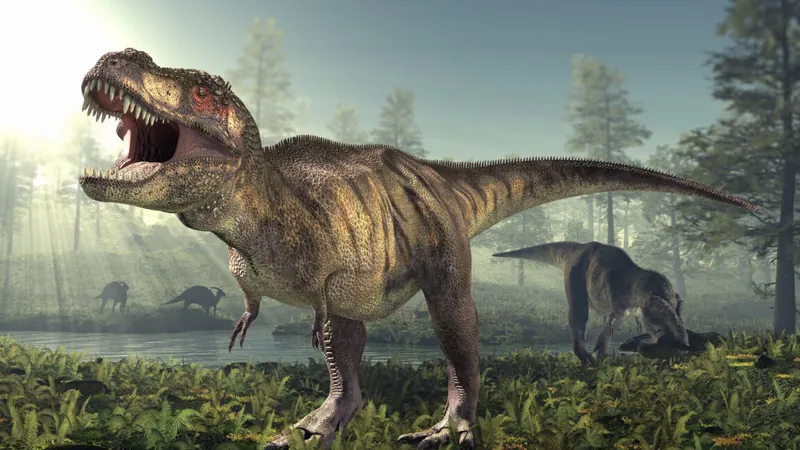
The TRUTH Behind the Battle of the Giants: Why T. Rex Would Have Dominated Spinosaurus!
2025-08-08
Author: Ying
Everyone remembers the epic showdown between the Spinosaurus and T. rex in Jurassic Park III, right? While the cinematic clash painted the picture of two monstrous carnivores battling for supremacy, a new study suggests that size isn’t everything when it comes to a creature’s bite power.
Leading the charge in this groundbreaking research is paleobiologist Andre Rowe from the University of Bristol. He asserts that if the T. rex and Spinosaurus had coexisted, the formidable T. rex would most likely have emerged victorious.
Learning from the Giants
Thanks to a treasure trove of fossil records, scientists have mapped out the anatomy of T. rex better than any other giant carnivore. These scans reveal that its bite force rivals that of the strongest animals known to man! But due to fewer fossils of Spinosaurus and other giant predators like Allosaurus, researchers previously assumed they shared similar hunting capabilities.
Rowe set out to debunk this myth. He tackled the challenge of outdated fossil documentation techniques by employing cutting-edge 3D scanning technology. His mission? To digitally reconstruct 3D models of 18 different dinosaur skulls and unveil the truth about their bite power.
A Closer Look at Their Anatomy
Upon examining the skull structures, an intriguing pattern emerged: the iconic T. rex skull is broad and sturdy, expertly designed for bone-crushing. In stark contrast, the skulls of Spinosaurus and its kin were slender and not equipped for delivering devastating bites.
Through sophisticated computer simulations, Rowe discovered that attempting a T. rex-style bite would result in significant damage to the skulls of other dinosaur carnivores. This crucial detail changes everything we thought we knew about them!
The Strategies of the Apex Predators
The Allosauroidea lineage boasts a unique approach, using 'low stress, low power strategies.' Think of them like giant lizards that slice and tear at prey—each attack a slow bleed rather than a single lethal strike. Rowe likens Allosaurus attacks to a “death by a thousand cuts,” where they wouldn’t exert much force, but their technique was deadly.
Then there's the Spinosaurus, often regarded as the odd one out. Notably, it was known to fish along shorelines, but the dietary variety it exhibited—from the remains of pterosaurs to the fossils of iguanodons found in related species—indicates it was a generalist feeder. However, Rowe explains it couldn't match the T. rex in ferocity or bite strength.
The Supreme Predator of Its Time
Unlike its counterparts, T. rex had rigid skulls—attributes that allowed it to thrive as a specialized ambush predator. Rowe equates its jaw structure to that of modern crocodiles, boasting reinforced jaws capable of executing strong, crushing bites. With archaeological evidence of T. rex teeth embedded in the bones of its herbivorous prey, we find testament to its hunting prowess.
So, the hypothetical battle that dazzled audiences in Jurassic Park III—painting Spinosaurus as the top predator—might have ended quite differently in reality. As Rowe succinctly puts it, 'The T. rex was built to fight; the Spinosaurus was not.'
This exciting research prompts us to rethink what we know about these prehistoric titans, proving that in the world of dinosaurs, sheer size doesn’t always dictate success!



 Brasil (PT)
Brasil (PT)
 Canada (EN)
Canada (EN)
 Chile (ES)
Chile (ES)
 Česko (CS)
Česko (CS)
 대한민국 (KO)
대한민국 (KO)
 España (ES)
España (ES)
 France (FR)
France (FR)
 Hong Kong (EN)
Hong Kong (EN)
 Italia (IT)
Italia (IT)
 日本 (JA)
日本 (JA)
 Magyarország (HU)
Magyarország (HU)
 Norge (NO)
Norge (NO)
 Polska (PL)
Polska (PL)
 Schweiz (DE)
Schweiz (DE)
 Singapore (EN)
Singapore (EN)
 Sverige (SV)
Sverige (SV)
 Suomi (FI)
Suomi (FI)
 Türkiye (TR)
Türkiye (TR)
 الإمارات العربية المتحدة (AR)
الإمارات العربية المتحدة (AR)